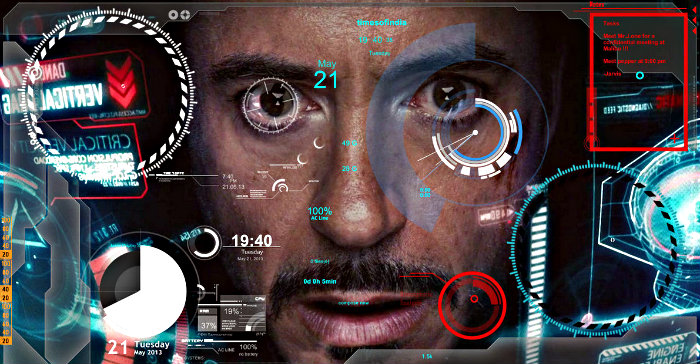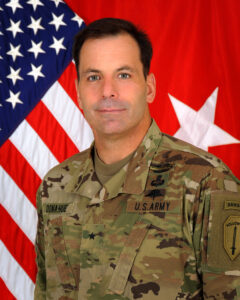
Tony Stark (Robert Downey Jr.) uses a cool-looking but somewhat cluttered Head-Up DIsplay (HUD) in his Iron Man suit. (Marvel Comics/Paramount Pictures)
AUSA GLOBAL FORCES SYMPOSIUM: In 18 months, US Army soldiers will test a new helmet-mounted display, nicknamed HUD 3.0, that could help them aim better, navigate better, and even train against virtual enemies projected onto their field of view, generals said here Wednesday. The effort involves two of the eight high-level Cross Functional Teams created to field radical improvements rapidly.
Superimposing digital data on the physical world this way is called augmented reality. (By contrast, virtual reality is when the user sees only digital imagery). The closest civilian equivalent would be cross between a militarized Pokémon Go and ruggedized Google Glasses. The military’s go-to model, however, is the Head-Up Displays or HUDs found in fighter jets, which project data on a transparent pane in front of the pilot so they can check their instruments while still scanning the sky for danger, without having to look down at dials and screens (hence “head-up display”).
That kind of technology has become common in combat aircraft, but previous efforts to miniaturize it for foot troops failed. When soldiers need to check their digital maps, for instance, they have to pull out their devices and look down, taking their eyes off the real battlefield around them. Now the Army thinks it can make a HUD for the infantry and get it right.

A Samsung Galaxy loaded with the military’s ATAK command-and-control software
Skipping from HUD 1.0 to HUD 3.0
By October, the Army will finish testing and start fielding what it’s calling HUD 1.0, the new Enhanced Night Vision Goggles – Binocular. Besides enhancing soldiers’ ability to see in the dark better than current night sights, the ENVG-B also can superimpose tactical data over the user’s field of view. That includes information from the tactical network about, say, friendly unit locations.

Brig. Gen. Christopher Donahue
It also includes a cross-hairs (formally, a targeting reticle) digitally linked to your weapon and displays precisely where the bullet would land if you pulled the trigger now. In testing, it’s already improved the wearer’s marksmanship significantly, according to Brig. Gen. Christopher Donahue, handpicked head of the service’s Cross Functional Team (CFT) for Soldier Lethality.
The next evolution is an augmented reality display that can be attached to the current helmet and used for both real-world operations and training, Donahue told reporters here. In addition to real-life data from the tactical network, HUD 3.0 will be able to superimpose purely digital terrain, obstacles, and even enemies over the wearer’s field of vision, allowing a unit to run much more complex and challenging training scenarios.
Today, major Combat Training Centers like Fort Irwin, Calif. feature an “opposing force” (OPFOR) of specially trained troops to fight against visiting units, but wargames there are expensive and a soldier would be lucky to go once a year. With HUD 3.0, soldiers could train against an augmented-reality OPFOR every day at their own home bases. When you ran across the digital enemy, said Maj. Gen. Maria Gervais, who runs the digital training Cross Functional Team, HUD 3.0 would superimpose on your vision “an enemy soldier that looks and acts just like that soldier would.”

Maj. Gen. Maria Gervais
But wait — what happened to HUD 2.0?
An intermediate model between ENVG-B and the HUD 3.0 was in the original plan, said Donahue and Gervais. But as the CFTs worked with industry, they discovered the technology available was advanced enough “you can go faster and skip a step,” Gervais said.
Donahue credited Gervais with finding the critical contractor. “She introduced us to an industry partner — we’re not going to comment on the name — but we’re already teaming with them to build that prototype fairly quickly,” he said. “The goal is to have a final prototype that we can test in 18 months.”
There’s a lot left to work out, both technically and tactically. The HUD needs to be made light, compact, rugged, and easier to use — unlike the infamous Land Warrior reticle that effectively blinded the user in one eye and broke easily. The final device also needs some kind of settings menu or dial that controls how much detail the user is seeing. A platoon leader planning an operation, or a sergeant leading a squad through a forest towards an objective, may want much more detailed tactical symbology than a regular rifleman in the middle of a firefight.
“We’ve got to figure that out,” said Gen. Stephen Townsend, the new head of Army Training & Doctrine Command (TRADOC). To start with, he said, “there’s fairly simple stuff that I need. First of all, where am I? Where are my buddies? And where is the enemy?….Then other stuff could be optional.”
Move over FARA: General Atomics pitching new Gray Eagle version for armed scout mission
General Atomics will also showcase its Mojave demonstrator for the first time during the Army Aviation Association of America conference in Denver, a company spokesman said.


























